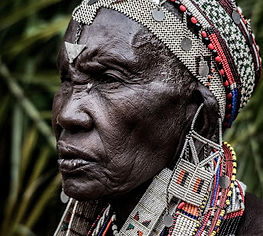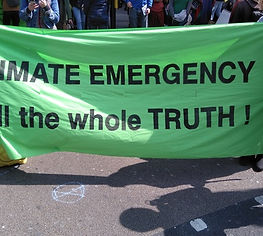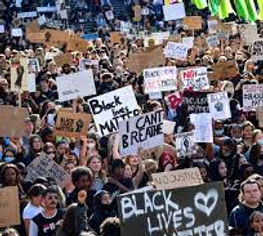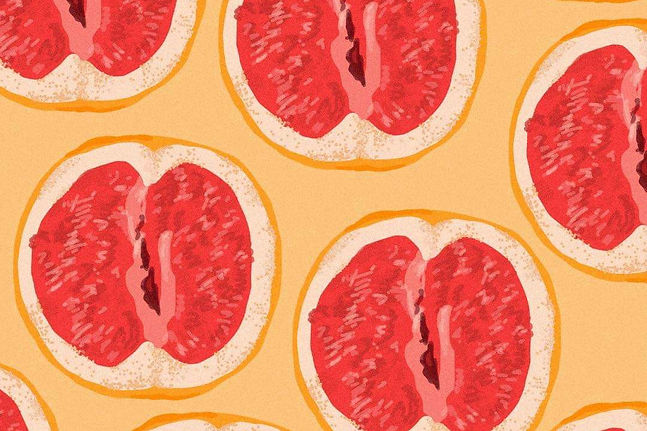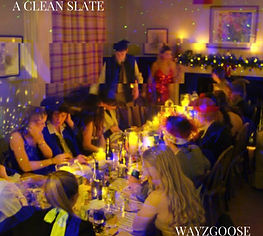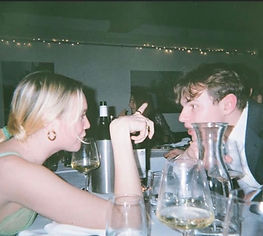Emma Simon
I might be wrong but it’s possible that the emotional and social similarities of environmentalism and religion might not have crossed your minds much recently. With the Black Lives Matter movement fighting for social justice, as well as Coronavirus ravaging the “global stage”; it’s almost impossible to see beyond the pandemic tunnel vision that has developed. Coronavirus has completely dominated politics, the media, the economy and seems to transcend the ever-changing public focus; and I am hopeful that BLM can do the same. However, unlike these two public discussions, environmentalism is very much a victim of the media’s short attention span.
This sounds like a rather hopeless tone to be setting, but actually it’s the opposite. Where previously environmentalism has been chained to the confines of media trends, it’s now leaving those chains behind. Environmentalism may not be the apple of the public eye right at this moment, but it seems to have established itself beyond that, as something with a right to exist on its own without the crutches of news coverage. It has become a movement, an entity with which more and more people are identifying. To be environmentally mindful has become less of a fashion statement and more of a lifestyle with values and practices and beliefs – something with the echoes of a religion.
Now, these echoes weren’t something I’d previously thought much about and, at first glance, they felt strange to me. Having thought about it though, there is something beneath this which might be quite important. Don’t get me wrong, I haven’t found it easy to understand, and I don’t expect you to either, but bear with me, I’m going to walk you through it and it might become clearer and potentially even interesting – but don’t hold me to that.
Before I start let me address one thing: whether you read this from a perspective of belief, disbelief, uncertainty or indifference to any faith, we can all agree that religion is unavoidably, and often beautifully heaped, with emotion and ambiguity. The battle between empirical evidence and faith is the essence of religious belief and it often causes an intensely personal struggle for anyone who spends even a minute thinking about it. This is one thing I want to make clear; religion is difficult and complex which is why I’m having a hard time putting it into a little box without subsections or branches. But, what I refer to here is religion as a social structure, a set of movements made up of various component parts, from belief and hope to ideals and perfections. This isn’t a ploy to undermine religion’s intricacy; and anyway, there is no world in which I have the kind of power to do that. Instead I want to make religion our reference point, something identifiable and contained despite its complexities. It is in this case that the yardstick against which environmentalism is to be measured.
It might sound like I’m taking the emotion out already, which I said was an unavoidable symptom of this discussion – but the clue is in that word – I can’t and also don’t want to avoid it. I’ve realised that for environmentalists , emotion is unavoidable as well. Their campaigns, global strikes and lifestyle alterations aren’t just the result of scientific research that proves the disastrous effects of our consumerist and industry-driven lifestyles. The motivation for these environmentalist practices are inherently emotional, driven by a belief system that sometimes goes unnoticed even by those who adopt it.
The term ‘belief system’ might sound out of place in a social movement inspired by empirical knowledge and scientific testing. Not only that but, in what is widely considered an increasingly secular society, believing in something unquantifiable has become a peripheral notion. We are working and thinking in a time defined by tangible truths and a post-enlightenment emphasis on evidence and facts. As a result, the concept of believing in something beyond oneself has become something almost exclusively associated with religion. But I would argue belief is, by definition, something entrenched within everything. It doesn’t just refer to the ethereal world of a God or set of gods but underlies the interactions of everyday life. You do not have to identify with a religion to be driven by a belief system – but to be driven at all does require belief. It is the basis upon which we make our decisions, back up our arguments and direct our actions. The belief behind an environmentalist perspective reclaims this broader definition as the basis for successfully navigating life.
Belief systems have and always will be innately connected to religion but, looking closely it seems they’re essential to environmentalism too. This notion of belief is quite important – just keep it in mind – it is the scaffolding for this whole discussion, and this is where the colour green comes in handy.
I can easily sit here and assure you that there is a belief system behind environmental protectionism – that’s all very well – but it’s also immaterial if we don’t actually know what these beliefs are. Here, the notion of believing in an ideal comes into the limelight and looking at it through a green lens is quite interesting. Now, I know that green might seem like a particularly uninspired choice for this article, but I’ve come to think that it might be more significant than just a generic environmental poster-colour. Greenness represents nature; now hear me out because I resent that cliché just as much as you do. What I’m saying is that the nature it represents is uninterrupted, uncorrupted by industry, pollution, plastic or deforestation. It illustrates an ideal of a self-contained perfect nature, without negative human disruption. You may even consider it a nature pre-human, before what we now ironically call civilisation’s ‘natural’ global progression.
Looking at it like this, Greenness begins to inhabit a multidimensionality that is normally overlooked. In a sense, Greenness is the ideal towards which environmentalism is steered. It is the image of a perfect world in which progress is sustainable and the environment is untarnished by the hand of human commerce.
Striving for a certain perfection isn’t something only environmentalists do; it is the basis of almost every established world religion, and I would argue, is the thing around which beliefs revolve. It’s funny because so far, I’ve displayed these two entities as similar but separate, but arguably their common ground isn’t limited to their development patterns. In fact, one central Christian ideal coincides quite remarkably with environmentalism. The idea of unharmed nature is at the heart of the Christian understanding of the Garden of Eden. It is a Paradise which Christians believe to be untouched by sin and the knowledge of evil, which echoes the environmental hope for the world, untouched by pollution and ecological destruction.
Shintoism and Animism also take root in these shared environmental principles, understanding nature to be a collection of spirits and gods which dwell within all living things. In these traditions, respect for nature is paramount and cultivates the utmost care for the environment simply by considering it as something other than a means to a human end. We shamefully perpetuate a culture in which nature is often considered an obstacle in the way of human development, when really, for nature, we are the obstacle. I am not here to preach, but that sense of human superiority that seems to have developed is undeniably unsettling.
The importance of ecological protection is evident in many religious traditions – whether it be Christian stewardship, or Animism’s approach to nature – to the point where it could just be seen as a subset of religious traditions. However, I’ve noticed one important difference, and that’s spirituality. Environmentalism has no need for a divine or spiritual otherness, whereas religion depends almost entirely on a belief in something outside provable scientific boundaries. This differentiation is important, but regardless of the contrasting nature of their belief systems, there is an underlying similarity which I have kept back until now. This is the striking power of hope which is essential to both religious belief and environmental belief. It is hope in the possibility of actually achieving the ideal of perfection being aspired to, whether that be a spiritual or an ecological paradise.
Of course, it may sound obvious but, without this sense of hope, the change that’s happening in lifestyle, politics, laws or traditions would be aimless. If there’s no hope of change occurring, why change at all? Hope is what spurs the global and personal action which has become increasingly evident in the news, on social media and from person to person. If you’re vegan because you know the environmental impact of dairy farming and meat production, it is because you have hope that a change in your lifestyle might help to achieve an environmentally ideal world. It is this hope which incites the change in the first place. As a social structure, environmentalism depends on this optimism as it develops into bigger and stronger movements like strikes and global campaigns.
Funnily enough, this isn’t a completely new concept. The French sociologist Bordieu explored this idea in depth and ultimately came up with what he called habitus. Habitus is the collective adoption of a perception of the world. It is the very normal way that we all assess the world, understand it in a particular way and then navigate it accordingly. He goes on to say how this becomes a pattern; by nature, we’re programmed to develop approaches to certain circumstances and then gravitate towards others who approach the world in the same way. People with shared perceptions and reactions are drawn to each other and become groups with a collective sense of purpose. This comfort and strength in familiarity is not a completely foreign concept; it’s the basis of any value structure and worldview, from environmentalism to Hinduism. It’s evident also in rituals across thousands of traditions; Extinction Rebellion, vegetarianism, Ramadan, Hajj, and Shabbat, to name only a few, and although they differ in origin, they display elements of that same habitus.
As this sense of collective environmental purpose grows traditions start to form, just as with established religions. It seems to me that when celebrations or practices become officially associated with a set of beliefs, it consolidates the purpose and meaning of the movement. The creation of Earth Day in 1970, celebrated on 21st March, is just one example of this. In a sense, I’ve come to think of environmentalism as a structure which people identify with and live their lives according to. It’s so unusual to consider a new belief system forming in the 20th and 21st century when often, and I’m no exception to this rule, people see belief as something potentially dated and historical. But, having looked into this more, environmentalism seems to be an example of just that; a scientific, post-enlightenment, unspiritual ‘religion’ which will endure for the attainment of an environmental paradise. And it’s with that thought that I end this article; religion and environmentalism are cut from the same hopeful, sociological, emotional cloth. One of collective beliefs, deeply held ideals, and ideologically inspired intentions.
